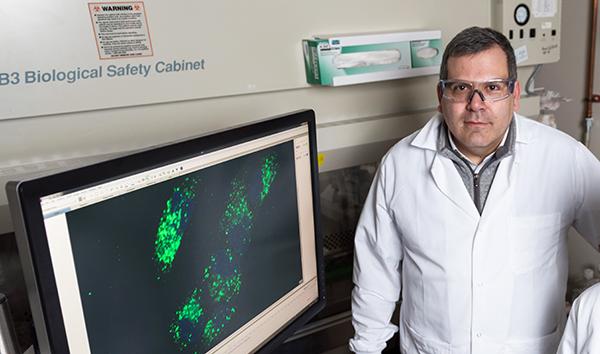Phil Santangelo, associate professor in the Wallace H. Coulter Department of Biomedical Engineering at Georgia Tech and Emory University, knows that preventing both HIV and flu infections are two tremendous challenges in the field of infectious disease. With support from the Bill and Melinda Gates Foundation and the NIH, the Santangelo lab is using RNA-based therapies to confront these challenges head on. His work is focused on the development of mRNA-based therapies, and the development and engineering of new molecular imaging technology for the interrogation of viral infections and immunodynamics.
Throughout last year, the Santangelo lab has been working on a safe, RNA-based gene therapy for preventing HIV infections in women. In two large animal models, his research has demonstrated broadly neutralizing antibody production for over 28 days with a single administration, and protection of biopsies from HIV challenge—encouraging results in the area of HIV prevention.
Santangelo is noted as a “thought-leader” in both the areas of HIV imaging and the characterization of infections at the single cell level. Santangelo’s imaging of CD4+ cells in vivo has been noted by Francis Collins, the director of NIH, on his blog.
Accomplishments by Phil Santangelo include:
• A new assembly mechanism for respiratory syncytial virus particles was discovered.
• The first PET/CT contrast agent to image SIV and SHIV infected cells within live animals was demonstrated.
• The first PET/CT contrast agent for imaging immune cells in macaques was demonstrated, and was used to validate the efficacy of a new treatment for HIV.
• The first RNA-based therapeutic for the prevention of RSV was demonstrated in rodents, with flu experiments underway.
• The first RNA-based therapeutic for the prevention of HIV was demonstrated in sheep and macaques.
His research has demonstrated that through the application of engineering principles to infectious diseases and other pathologies, significant impact can be achieved regarding both our fundamental understanding of pathogenesis, but also how these pathologies can be both prevented and treated.
Media Contact
Walter Rich
Keywords
Latest BME News
Jo honored for his impact on science and mentorship
The department rises to the top in biomedical engineering programs for undergraduate education.
Commercialization program in Coulter BME announces project teams who will receive support to get their research to market.
Courses in the Wallace H. Coulter Department of Biomedical Engineering are being reformatted to incorporate AI and machine learning so students are prepared for a data-driven biotech sector.
Influenced by her mother's journey in engineering, Sriya Surapaneni hopes to inspire other young women in the field.
Coulter BME Professor Earns Tenure, Eyes Future of Innovation in Health and Medicine
The grant will fund the development of cutting-edge technology that could detect colorectal cancer through a simple breath test
The surgical support device landed Coulter BME its 4th consecutive win for the College of Engineering competition.








